Southeast Asia Industrial and Service Robot Market Size
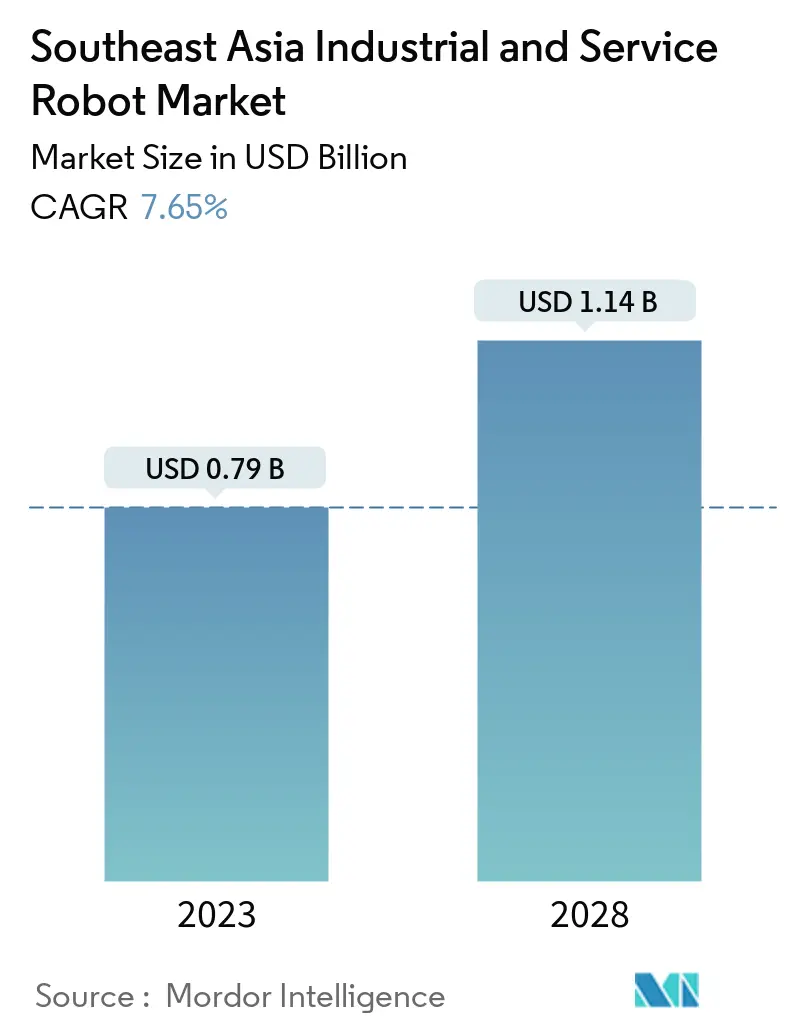
| Study Period | 2018 - 2028 |
| Market Size (2023) | USD 0.79 Billion |
| Market Size (2028) | USD 1.14 Billion |
| CAGR (2023 - 2028) | 7.65 % |
| Fastest Growing Market | Asia Pacific |
| Largest Market | North America |
Major Players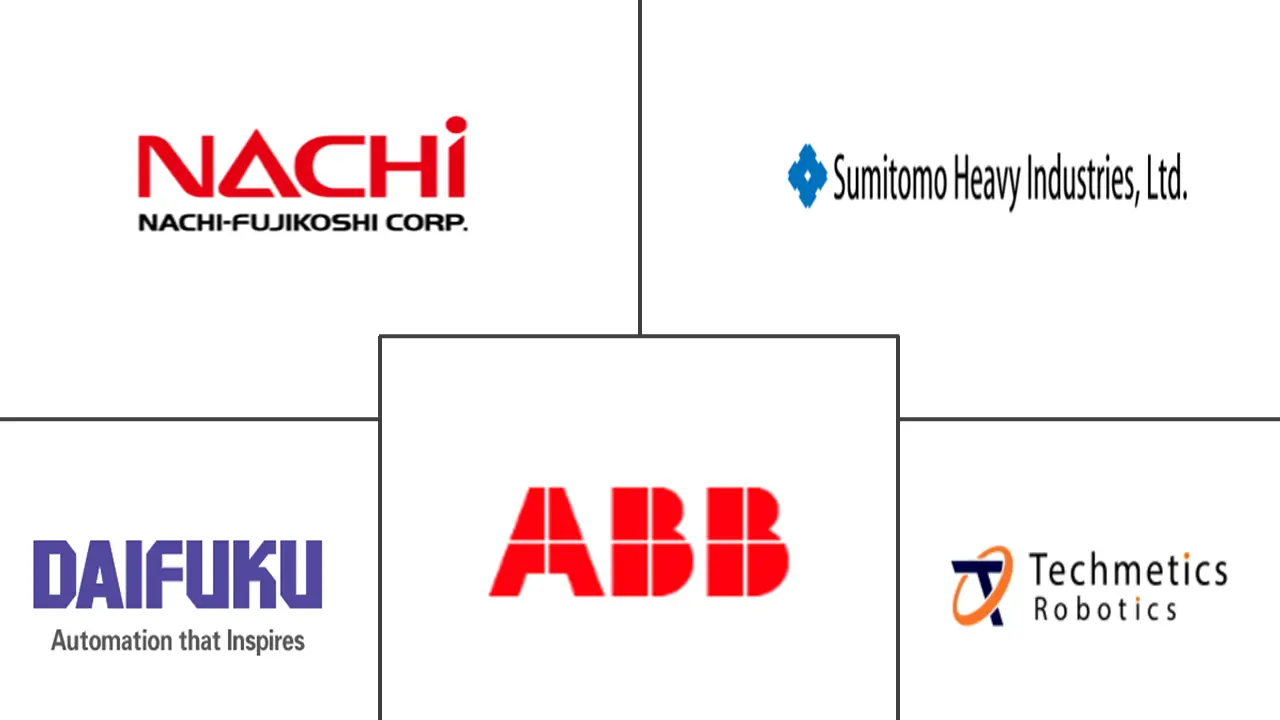
*Disclaimer: Major Players sorted in no particular order |
Need a report that reflects how COVID-19 has impacted this market and its growth?
Southeast Asia Industrial and Service Robot Market Analysis
The Southeast Asia Industrial and Service Robot Market size is expected to grow from USD 0.79 billion in 2023 to USD 1.14 billion by 2028, at a CAGR of 7.65% during the forecast period (2023-2028).
The adoption of robots (industrial as well as service robots) is increasing in Southeast Asian countries. According to the International Federation of Robotics (IFR) estimate, the sales of robots in the region are expected to grow between 20% and 25% in recent years.
- The aging societies of Southeast Asia, such as Singapore and Thailand, are driving growth in the medical industry sector, creating a massive market for service robots in the region. According to the Singapore department of statistics, in 2021, around 0.28 million inhabitants were 65 years or older. This encourages several companies to invest in products for the elderly population in the region.
- Improving productivity in industries like logistics that require tasks will be dependent on much cheaper robots. However, robots are already contributing to driving productivity. From picking up garbage, cleaning streets, preparing/delivering food, and providing room service in hotels, the opportunity and benefits of the industrial and service robots will be endless.
- In addition, prominent vendors are looking to invest in the region to develop rehabilitation robots. For instance, Ekso Bionics entered into a joint venture with Zhejiang Youchuang Venture Capital Investment Co. Ltd worth USD 100 million. This JV will develop, sell, and support exoskeleton products in China, Singapore, Hong Kong, and Malaysia.
- Southeast Asia countries are ahead in robot adoption. However, there are likely many contributing factors that expedite robot adoption rates in the region. For instance, some of the leading countries in the region have established national goals and unique strategies to support robotics innovation and robot adoption. Some Southeast Asian nations have proactive tax policies to provide advanced robot technology adoption incentives.
- Amid the COVID-19 pandemic, southeast Asian countries got more push toward digital transformation across industries. This also propelled the adoption of robots in the region. Vietnam, for instance, experienced a depletion, yet the Asian Development Bank (ADB) forecasted Vietnam as one of the fastest-growing economies in Southeast Asia. The country employed robots and drones to transport medical aid, infectious samples, food and essential deliveries, sterilization, and surveillance of the public and public areas.
Southeast Asia Industrial and Service Robot Market Trends
This section covers the major market trends shaping the Southeast Asia Industrial & Service Robot Market according to our research experts:
Increasing Aging Population to Drive the Growth of the Market
- Geriatric patients access the physiotherapy industry for health conditions, such as a stroke, recovery after an injury, or a surgical procedure, such as hip or knee replacement. Physiotherapy helps elderly adults to improve and maintain their strength, range of motion, and mobility and reduces their risk of injuries and falls.
- An independent survey by Wellchem Pharmaceutical to mark World Arthritis Day stated that about 40% of elderly Singaporeans had experienced knee pain for five years or more. Because by 2025, 22% of the world population may be older than 60, according to the World Bank, the demand is only going to increase, thus, making service robots a lucrative market to invest in. Moreover, vendors in the region are involved in product innovation to get certified by medical councils and launch their products in the market.
- The concern of elder care is one of the factors like supply and demand. As the senior population increases, the number of caregivers is not increasing. Using robots for elderly care will vastly reduce the current astronomical cost of elderly care. Additionally, it will pick up the slack regarding the number of caregivers available as the ratio of elderly to nonelderly people shifts.
- However, the higher costs of service robots are associated with powerful and robust hardware and efficient software. Apart from high prices, these products also require a higher level of maintenance than a manually operated machine. They generally have a lower degree of flexibility regarding possible products (even flexible automation is less flexible than humans, the most versatile tools of all).
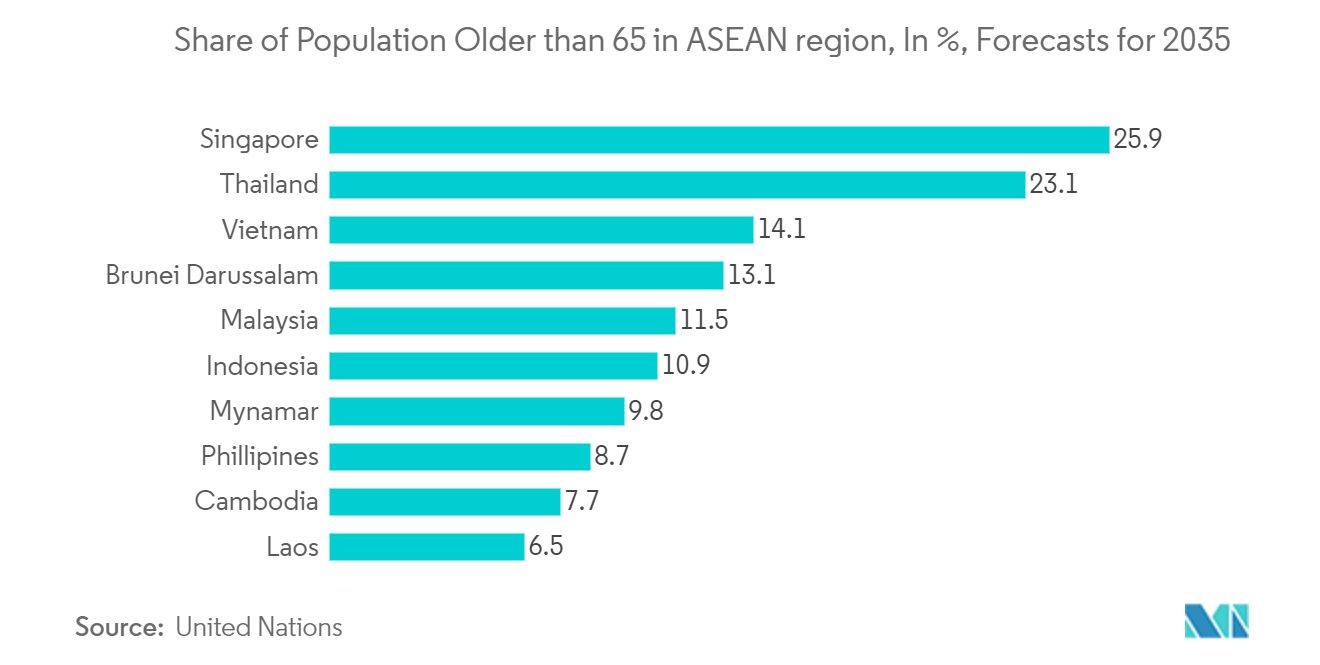
Industrial Robots to Witness Significant Growth
- Singapore has taken several future steps to establish the country as the host of the world's second most robot-intensive manufacturing sector, behind only South Korea. Using industrial robotics increases productivity and boosts output in the manufacturing industry globally. As robotics solutions become more widely adopted, it is only natural that the implementation costs will reduce. Robotics solutions to perform tasks. For instance, the industrial robots in several manufacturing plants and mobile robots are among the features that contribute hugely to this ongoing success in Singapore.
- Technological innovations concerning cognition, interaction, and manipulation, have made industrial robotics more appealing. Technology and other component providers have moved the robotics ecosystem forward. The COVID-19 pandemic has made businesses recognize the need for automation and robotics for various processes.
- Singapore's economy, industries, and society have significantly benefitted from robotics solutions. Harnessing fourth industrial revolution (4IR) technologies, including industrial robots and cobots, is one of the unique ways that the country pursues to strengthen its industries. Singapore, a powerhouse with multiple manufacturing plants, has a highly skilled workforce and is a global leader in microchip and semiconductor manufacturing. It excels in advanced manufacturing, which employs Smart digital technologies for production and business activities. Those technologies include industrial robots, thus driving the demand.
- Singapore's manufacturing sector is witnessing significant growth, posing no boundaries. Singapore is one of few countries to successfully reverse the decline in the manufacturing sector's share of GDP (Gross Domestic Product), driven by industrial robots. Increasingly, robots are fulfilling frontline roles and serving important safe distancing purposes while no longer merely serving as a curiosity.
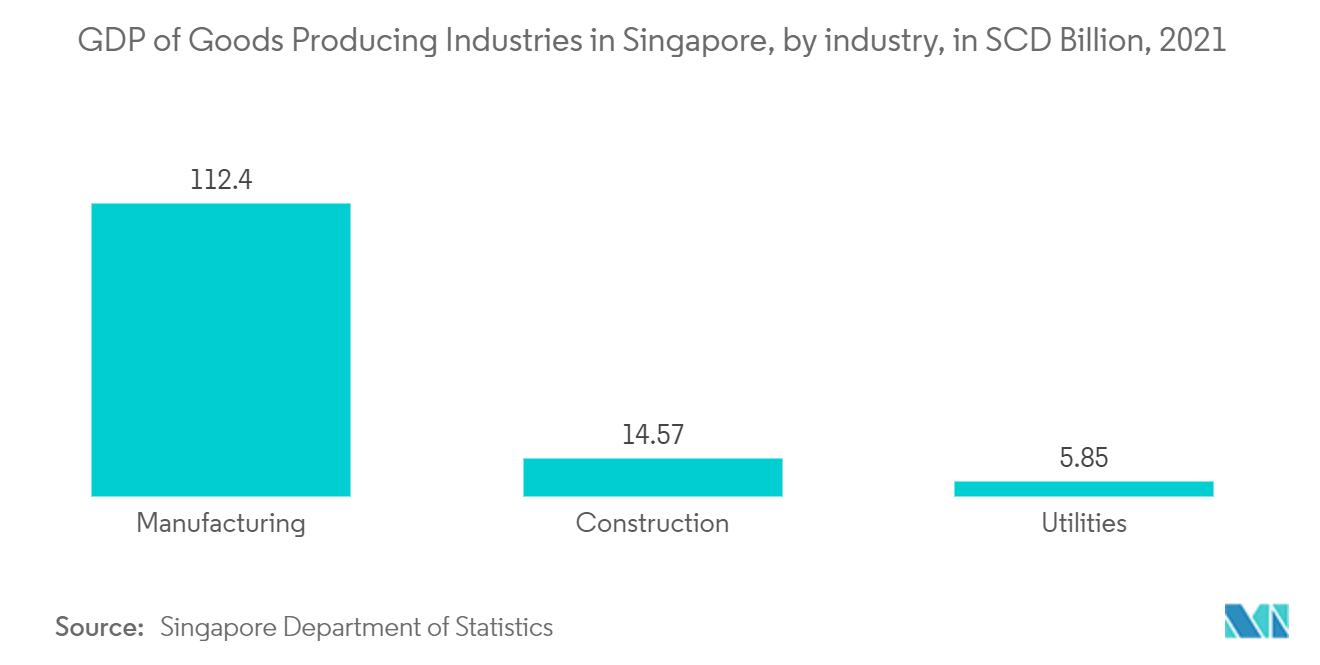
Southeast Asia Industrial and Service Robot Industry Overview
The Southeast Asia Industrial and Service Robot Market is very competitive in nature. Some of the significant players in the market are ABB Ltd Daifuku Co. Ltd, Nachi-Fujikoshi corp, Sumitomo Heavy Industries, Ltd., and many more.
- September 2022 - Sumitomo partnered with Dexterity Partner to Deploy 1,500 Robots in the warehouses by 2026. The full-task robots Dexterity deployed have increased demand for flexible automation that operates in existing infrastructure and workflows. The SaaS platform equips robots with the sense of touch, vision, and handling complicated and intelligence to multi-task, goods, and achieve beyond-human in repetitive tasks. The distribution agreement with Sumitomo, a Japan-based Fortune 500 multinational, will enable Dexterity to offer its RaaS business to warehouses.
- July 2022 - Dreame Technology partnered with Robocon. Dreame's innovative designs continue to drive the development of robotics. Together with ROBOCON, Dreame established the FOR DREAM - Dreame Technology Robotics Innovation Fund to support outstanding students in their scientific and technological innovations. The company has evolved from the cleaning robot sector to a broader range of pan-mobile robots, such as quadruped robots, and offers professional and attentive technical logic support.
Southeast Asia Industrial and Service Robot Market Leaders
NACHI-FUJIKOSHI CORP
Sumitomo Heavy Industries, Ltd
Daifuku Co. Ltd
ABB Ltd
Techmetics Robotics
*Disclaimer: Major Players sorted in no particular order
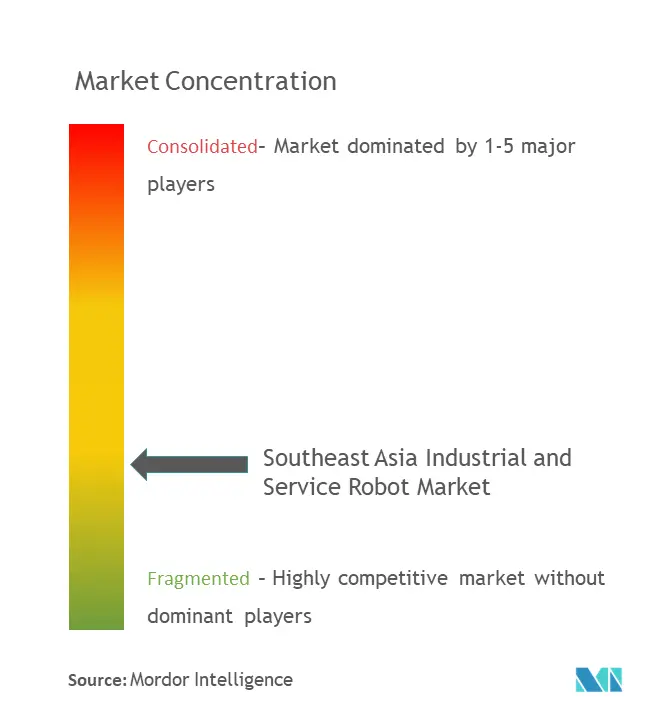
Southeast Asia Industrial and Service Robot Market News
- October 2022 - Dreame, specializing in smart home cleaning devices, launched Dreame Bot W10 Pro, a new vacuum cleaning robot. The smart vacuum robot cleaner has a camera featuring the REAL3 Time of Flight (ToF) image sensor from Infineon Technologies AG and pmd technologies. The ToF imager enables smart navigation, 3D mapping, and tremendous obstacle avoidance for service robots, cleaning robots, and mops.
- July 2022 - Nachi fujikoshi corp has introduced three new robots, the MZ07LF, and MZ07F, with higher speed and precision MZ07. The MZ Series has earned fame in the industrial machinery, electric and electronic sectors, and a wide range of other industries and is contributing to improving productivity at manufacturing sites. The new robots are designed for both lightweight and high rigidity, ensuring high-speed, high-precision operation, and contributing to improved customer productivity.
Southeast Asia Industrial and Service Robot Market Report - Table of Contents
1. INTRODUCTION
1.1 Study Assumptions and Market Definition
1.2 Scope of the Study
2. RESEARCH METHODOLOGY
3. EXECUTIVE SUMMARY
4. MARKET INSIGHTS
4.1 Market Overview
4.2 Industry Attractiveness - Porter's Five Forces Analysis
4.2.1 Bargaining Power of Suppliers
4.2.2 Bargaining Power of Consumers
4.2.3 Threat of New Entrants
4.2.4 Threat of Substitutes
4.2.5 Intensity of Competitive Rivalry
4.3 Impact of COVID-19 on the Southeast Asia Industrial and Service Robot Market
5. MARKET DYNAMICS
5.1 Market Drivers
5.1.1 Increasing demand for Mobile Automation
5.1.2 Increased Efficiency for the Production Line
5.2 Market Challenges
5.2.1 High Initial Investments
5.2.2 Limitations in Terms of the Tasks the Robots (Industrial, Service) Perform
6. MARKET SEGMENTATION
6.1 By Country
6.1.1 Singapore
6.1.2 Thailand
6.1.3 Vietnam
7. COMPETITIVE LANDSCAPE
7.1 Company Profiles
7.1.1 NACHI-FUJIKOSHI CORP
7.1.2 Sumitomo Heavy Industries, Ltd.
7.1.3 Daifuku Co. Ltd
7.1.4 ABB Ltd
7.1.5 Techmetics Robotics
7.1.6 Dexterity, Inc.
7.1.7 Ourglass Pte Ltd
7.1.8 Relay Robotics, Inc.
7.1.9 Eureka Robotics
7.1.10 Dreame Technology
7.1.11 Delta Electronics Inc.
- *List Not Exhaustive
8. INVESTMENT ANALYSIS
9. FUTURE OF THE MARKET
Southeast Asia Industrial and Service Robot Industry Segmentation
The Southeast Asia Industrial and Service Robot Market is segmented by Geography. According to the International Organization for Standardization, a service robot performs practical tasks for equipment or humans, excluding industrial automation applications. Service robots are different in form and function compared to industrial robots. Service robots automate menial, time-consuming, or repetitive tasks, thereby releasing human workers to achieve more intellectual functionality. Additionally, personal service robots are consumer-facing robots for automating tasks, mainly within the home. This factor could include things such as autonomous vacuum cleaners or window cleaners. The Industrial robots can be classified according to the mechanical structure as articulated, cylindrical, linear (including cartesian and gantry), parallel or SCARA robots used across the end-user industries in Southeast Asian countries.
The Southeast Asia Industrial and Service Robot Market is segmented by country (Singapore, Thailand, and Vietnam). The market sizes and forecasts are provided in terms of value (USD million) for all the above segments.
| By Country | |
| Singapore | |
| Thailand | |
| Vietnam |
Southeast Asia Industrial and Service Robot Market Research FAQs
How big is the Southeast Asia Industrial and Service Robot Market?
The Southeast Asia Industrial and Service Robot Market size is expected to reach USD 790.08 million in 2023 and grow at a CAGR of 7.65% to reach USD 1,142.19 million by 2028.
What is the current Southeast Asia Industrial and Service Robot Market size?
In 2023, the Southeast Asia Industrial and Service Robot Market size is expected to reach USD 790.08 million.
Who are the key players in Southeast Asia Industrial and Service Robot Market?
NACHI-FUJIKOSHI CORP, Sumitomo Heavy Industries, Ltd, Daifuku Co. Ltd, ABB Ltd and Techmetics Robotics are the major companies operating in the Southeast Asia Industrial and Service Robot Market.
Which is the fastest growing region in Southeast Asia Industrial and Service Robot Market?
Asia Pacific is estimated to grow at the highest CAGR over the forecast period (2023-2028).
Which region has the biggest share in Southeast Asia Industrial and Service Robot Market?
In 2023, the North America accounts for the largest market share in the Southeast Asia Industrial and Service Robot Market.
Southeast Asia Service Robot Industry Report
Statistics for the 2023 Southeast Asia Service Robot market share, size and revenue growth rate, created by Mordor Intelligence™ Industry Reports. Southeast Asia Service Robot analysis includes a market forecast outlook to 2028 and historical overview. Get a sample of this industry analysis as a free report PDF download.
